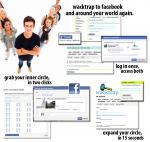What’s your story?
Share and find customer experiences
Connect with the people behind them
Wacktrap is
feedback made social
Trending Content
Identical Twin Mothers Prove Connection and Bond by Giving Birth on Same Day Within Hour
by copythat
If identical and fraternal twins are linked as closely as science and psychologists suspect—in a connection not just physically but also in mind—a most unusual delivery of newborns seems to further prove shared traits and the tightest of bonds that are uncommon to the rest of the world: Identical twin sisters in Utah have given birth less than one hour apart, or 43 minutes to be exact. No, doctors did not make it happen on October 7--but an an uncanny connection may have.
If it sounds like a virtual impossibility, it's actually happened -- twice -- literally just one year apart, minus a day.
Salt Lake City-area, Utah, identical twins Alicia Teeples and Ari Ostler seem to prove twins’ commonalities don’t end anywhere near after their own births. In what some call a coincidence -- and what others argue anything as but -- the two young women are proving that even the next stage of life can occur, again, together.
The 27-year-old women just gave birth -- at virtually the same time and despite any lack of medical interference or alter. It seems to be destiny.
October 7, Ari Ostler was blessed with a new baby boy at 4:15 p.m. Only 43 minutes later on October 7, Alicia Teeples’ new baby girl arrived to the world. Not quite too surprisingly, the two new babies are said to share an almost-identical looking nose. But that’s only the beginning.
The rest of the world may find it unusual, but maybe not the women themselves – whom have shared more than a multitude of similarities. Both like to spend time together and have worked as medical assistants for the same employer, a doctor in Utah, for the past eight years. The sisters married two men, friends with one another since middle school years.
While pregnant, the two identical twins experienced the same timing in morning sickness and even the same pregnancy-related complications. Despite the gender difference of their respective newborns, the womens’ stomachs carried the same measurements before delivery and during pregnancy – and they eventually discovered their new babies shared the exact same due date. But there were more similarities to come before actual delivery. Each baby’s umbilical cord began wrapping around its neck at nearly the same time – and the babies each released themselves from the umbilical cord at around the same time.
If it all sounds weird, it becomes stranger. Things may have been less odd or unusual had the individual babies actually arrived on their slated due dates – but neither did, leaving plenty of room for the path to change before eventual arrival to the world. Medical treatment didn’t determine a coinciding delivery for the twins and mothers.
In fact both babies arrived late. With complications and already being past the due date for giving birth, each woman was recommended by her doctor to opt for labor inducement. But while that doctor’s recommendation happened to coincidentally arrive on the same day, each new mother-to-be chose a different route. Ostler received an epidural in efforts to get things started. Meanwhile, Teeples continued on her path for efforts of a natural delivery. Despite it all, and despite two different avenues for reaching the end goal, it seems the newborn babies were destined to arrive almost simultaneously.
While labor for each Utah woman continued to pace the other, the babies eventually came to arrive less than three-quarters of an hour apart on the same day in October. If it sounds like it's never happened before, think again. One year ago, nearly the same day -- just one day apart on October 8, 2010.
Two fraternal twins and new mothers in Florida gave birth on the same day last year, just one day apart from Utah's identical twins that gave birth on October 7. The doctor treating the Florida mothers says the women conceived the children no more than 3 days apart, while living across the nation from one another -- an event most unusual. Fraternal twins Cristina and Alexandra Lima gave birth October 8 last year in Florida, claiming it was so difficult to be apart during pregnancy that they ended up texting one another 27 times per day during the process -- one twin sister eventually moving back to South Florida during pregnancy so that she could be with her fraternal twin sister while pregnant. Dr. Randy Fink at Baptist Hospital in Florida says even though the newborn babies are cousins and not twins themselves, they were already exhibiting what he says is very "twin-like" behavior -- a description that seems to fit the new babies born to the identical twin sisters in Utah.
Do twins share telepathy or a special telepathic connection the rest of the world is missing? Research and stories from both identical and fraternal twins seems to prove the concept true. Investigative reports and even Dateline have recently featured on-air specials, exploring the connections between twins -- from babies to adults. It's a bond that seems to offer no other explanation after babies exhibiting special forms of communication or language and adults describing a connection and tie like no other. In March, ABC explored two twins talking in communication representing their own special language -- shared only between the two children. It's been a hot topic lately for debate. With births of twins on the rise over recent years, the nation may have more opportunity for insight into the pairings than ever before.
Watch the experience of twin sisters Ruby and Rosie -- featured on Dateline just months ago, in May.
Location
SPEED UP YOUR ONLINE GROWTH
How To Wack
Take the Tour
Click on any image to start











